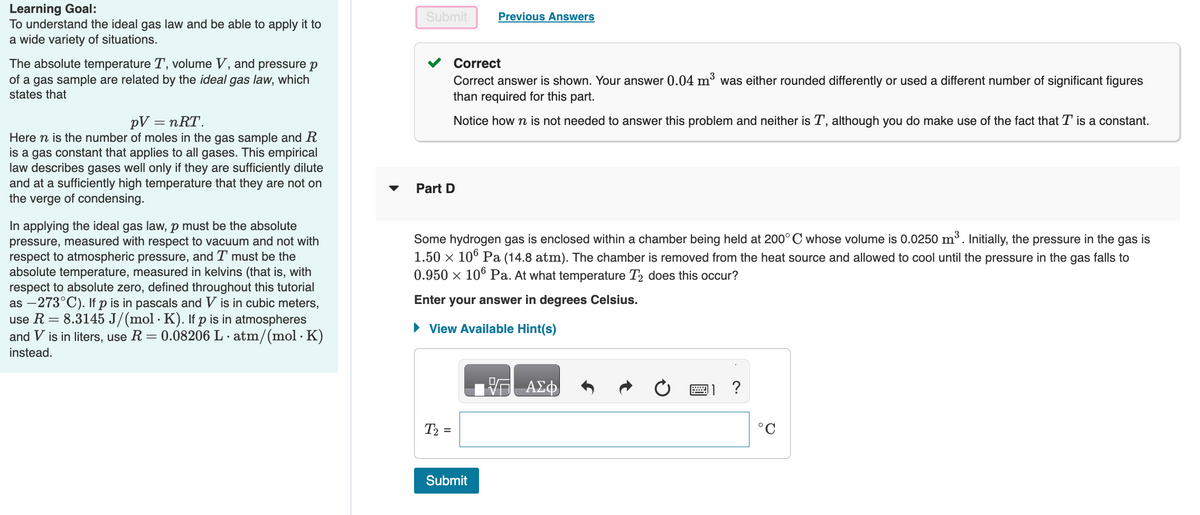Part D Some hydrogen gas is enclosed within a chamber being held at 200° C whose volume is 0.0250 m³. Initially, the pressure in the gas is 1.50 x 106 Pa (14.8 atm). The chamber is removed from the heat source and allowed to cool until the pressure in the gas falls to 0.950 x 106 Pa. At what temperature T₂ does this occur? Enter your answer in degrees Celsius. ▸ View Available Hint(s) T₂ = Submit 1971 ΑΣΦ www. ? °C
Part D Some hydrogen gas is enclosed within a chamber being held at 200° C whose volume is 0.0250 m³. Initially, the pressure in the gas is 1.50 x 106 Pa (14.8 atm). The chamber is removed from the heat source and allowed to cool until the pressure in the gas falls to 0.950 x 106 Pa. At what temperature T₂ does this occur? Enter your answer in degrees Celsius. ▸ View Available Hint(s) T₂ = Submit 1971 ΑΣΦ www. ? °C
Principles of Physics: A Calculus-Based Text
5th Edition
ISBN:9781133104261
Author:Raymond A. Serway, John W. Jewett
Publisher:Raymond A. Serway, John W. Jewett
Chapter16: Temperature And The Kinetic Theory Of Gases
Section: Chapter Questions
Problem 66P
Related questions
Question
part d

Transcribed Image Text:Learning Goal:
To understand the ideal gas law and be able to apply it to
a wide variety of situations.
The absolute temperature T, volume V, and pressure p
of a gas sample are related by the ideal gas law, which
states that
PV = nRT.
Here n is the number of moles in the gas sample and R
is a gas constant that applies to all gases. This empirical
law describes gases well only if they are sufficiently dilute
and at a sufficiently high temperature that they are not on
the verge of condensing.
In applying the ideal gas law, p must be the absolute
pressure, measured with respect to vacuum and not with
respect to atmospheric pressure, and I must be the
absolute temperature, measured in kelvins (that is, with
respect to absolute zero, defined throughout this tutorial
as -273°C). If p is in pascals and V is in cubic meters,
use R = 8.3145 J/(mol · K). If p is in atmospheres
and V is in liters, use R = 0.08206 L atm/(mol. K)
instead.
.
Submit
Part D
Correct
Correct answer is shown. Your answer 0.04 m³ was either rounded differently or used a different number of significant figures
than required for this part.
Notice how n is not needed to answer this problem and neither is T, although you do make use of the fact that I is a constant.
T₂ =
Previous Answers
Some hydrogen gas is enclosed within a chamber being held at 200° C whose volume is 0.0250 m³. Initially, the pressure in the gas is
1.50 × 106 Pa (14.8 atm). The chamber is removed from the heat source and allowed to cool until the pressure in the gas falls to
0.950 × 106 Pa. At what temperature T2 does this occur?
Enter your answer in degrees Celsius.
► View Available Hint(s)
Submit
ΑΣΦ
?
Q
Expert Solution
This question has been solved!
Explore an expertly crafted, step-by-step solution for a thorough understanding of key concepts.
This is a popular solution!
Trending now
This is a popular solution!
Step by step
Solved in 3 steps with 2 images

Knowledge Booster
Learn more about
Need a deep-dive on the concept behind this application? Look no further. Learn more about this topic, physics and related others by exploring similar questions and additional content below.Recommended textbooks for you

Principles of Physics: A Calculus-Based Text
Physics
ISBN:
9781133104261
Author:
Raymond A. Serway, John W. Jewett
Publisher:
Cengage Learning

Physics for Scientists and Engineers with Modern …
Physics
ISBN:
9781337553292
Author:
Raymond A. Serway, John W. Jewett
Publisher:
Cengage Learning

Physics for Scientists and Engineers
Physics
ISBN:
9781337553278
Author:
Raymond A. Serway, John W. Jewett
Publisher:
Cengage Learning

Principles of Physics: A Calculus-Based Text
Physics
ISBN:
9781133104261
Author:
Raymond A. Serway, John W. Jewett
Publisher:
Cengage Learning

Physics for Scientists and Engineers with Modern …
Physics
ISBN:
9781337553292
Author:
Raymond A. Serway, John W. Jewett
Publisher:
Cengage Learning

Physics for Scientists and Engineers
Physics
ISBN:
9781337553278
Author:
Raymond A. Serway, John W. Jewett
Publisher:
Cengage Learning

College Physics
Physics
ISBN:
9781938168000
Author:
Paul Peter Urone, Roger Hinrichs
Publisher:
OpenStax College


Physics for Scientists and Engineers: Foundations…
Physics
ISBN:
9781133939146
Author:
Katz, Debora M.
Publisher:
Cengage Learning